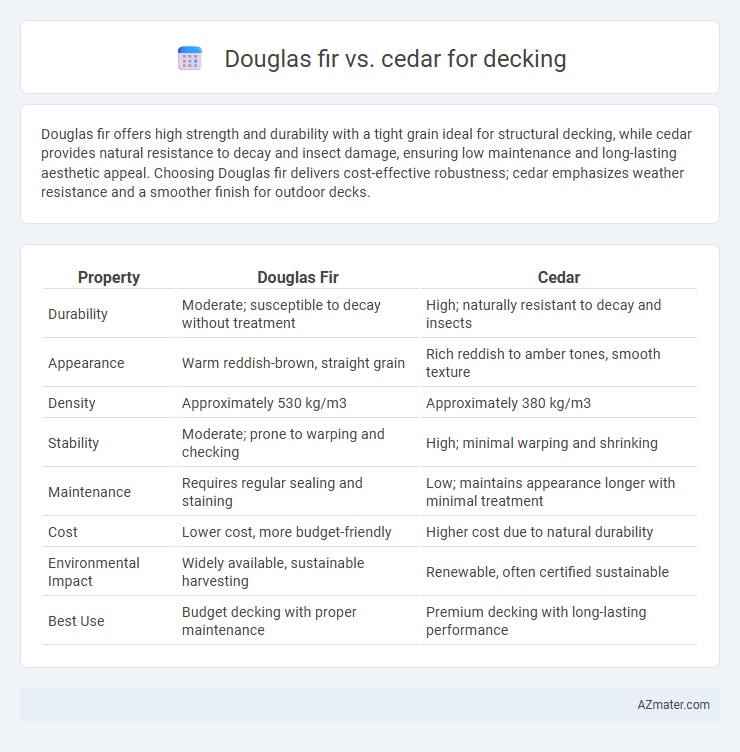Douglas fir offers high strength and durability with a tight grain ideal for structural decking, while cedar provides natural resistance to decay and insect damage, ensuring low maintenance and long-lasting aesthetic appeal. Choosing Douglas fir delivers cost-effective robustness; cedar emphasizes weather resistance and a smoother finish for outdoor decks.
Table of Comparison
| Property | Douglas Fir | Cedar |
|---|---|---|
| Durability | Moderate; susceptible to decay without treatment | High; naturally resistant to decay and insects |
| Appearance | Warm reddish-brown, straight grain | Rich reddish to amber tones, smooth texture |
| Density | Approximately 530 kg/m3 | Approximately 380 kg/m3 |
| Stability | Moderate; prone to warping and checking | High; minimal warping and shrinking |
| Maintenance | Requires regular sealing and staining | Low; maintains appearance longer with minimal treatment |
| Cost | Lower cost, more budget-friendly | Higher cost due to natural durability |
| Environmental Impact | Widely available, sustainable harvesting | Renewable, often certified sustainable |
| Best Use | Budget decking with proper maintenance | Premium decking with long-lasting performance |
Overview: Douglas Fir vs Cedar for Decking
Douglas fir offers high strength and durability with a coarse, straight grain that resists warping, making it ideal for structural decking applications. Cedar is prized for its natural resistance to decay and insect damage, along with a rich aroma and smooth texture that enhances aesthetic appeal. Both woods provide excellent decking options, but Douglas fir requires treatment for outdoor use, whereas cedar performs well untreated in moist environments.
Durability and Lifespan Compared
Douglas fir offers excellent durability with a natural resistance to decay and moderate insect resistance, making it suitable for decking in various climates; its lifespan typically ranges from 15 to 20 years with proper maintenance. Cedar is renowned for superior decay resistance and natural oils that deter insects, resulting in an average decking lifespan of 20 to 30 years, often outlasting Douglas fir in humid or wet conditions. Both woods require routine sealing or staining to maximize durability and lifespan, but cedar generally provides longer-lasting performance in outdoor environments.
Resistance to Rot, Decay, and Insects
Douglas fir offers moderate resistance to rot, decay, and insects, but it benefits significantly from proper treatment and sealing to enhance durability for decking applications. Cedar naturally contains oils and tannins that provide strong resistance to rot, decay, and insect damage, making it a preferred choice for outdoor decking without extensive chemical treatments. Choosing cedar reduces maintenance needs and extends the deck's lifespan, while Douglas fir requires more frequent preservation efforts to ensure long-term performance.
Appearance and Aesthetic Appeal
Douglas fir decking showcases a warm, reddish-brown hue with a straight, fine grain that enhances its natural elegance and complements a variety of outdoor styles. Cedar decking offers a distinctive rich reddish tint that weathers to a silvery gray, paired with a pronounced aromatic scent and a knotty, rustic texture that adds a classic charm. Both woods provide unique aesthetic qualities, with Douglas fir appealing to modern designs and cedar favored for its timeless, natural beauty.
Strength and Structural Qualities
Douglas fir is recognized for its exceptional strength and rigidity, making it a superior choice for structural decking applications where load-bearing capacity is critical. Its high density and favorable strength-to-weight ratio provide excellent resistance to warping and sagging over time. In contrast, cedar offers moderate strength but excels in natural decay resistance, requiring less maintenance but often necessitating additional support for heavy-duty structural use.
Maintenance Requirements
Douglas fir decking requires regular sealing and staining to protect against moisture, UV damage, and insect infestation, as it is more prone to weathering compared to cedar. Cedar naturally contains oils that resist decay, rot, and insects, reducing the frequency of maintenance such as sealing or staining. Over time, cedar decking tends to maintain its structural integrity and appearance with less intensive upkeep than Douglas fir, making it a preferred choice for low-maintenance outdoor projects.
Cost and Value Analysis
Douglas fir offers a more affordable option for decking with moderate durability, making it suitable for budget-conscious homeowners looking for a balance between cost and performance. Cedar commands a higher price but provides superior natural resistance to decay and insects, potentially reducing long-term maintenance and replacement expenses. When factoring overall value, cedar's longevity and aesthetic appeal often justify the initial investment, while Douglas fir may require regular sealing or treatment to maintain its lifespan.
Environmental Impact and Sustainability
Douglas fir decking is sourced from fast-growing, sustainably managed forests, making it a renewable option with a relatively low carbon footprint due to its efficient growth cycle. Cedar decking, particularly from Western Red Cedar, is prized for its natural resistance to decay, reducing the need for chemical treatments and extending the lifespan of the deck, which contributes to sustainability. Both woods offer environmental benefits, but Douglas fir's rapid replenishment rate often makes it a more eco-friendly choice for sustainable decking projects.
Ease of Installation and Workability
Douglas fir offers superior ease of installation and workability due to its straight grain and uniform texture, making it easy to cut, nail, and shape without splintering. Cedar, while also workable, tends to be softer and more prone to denting or gouging during installation, requiring more careful handling and pre-drilling for fasteners. The stability and dimensional uniformity of Douglas fir reduce installation time and labor costs compared to cedar, especially in larger decking projects.
Best Uses and Recommendations
Douglas fir offers high strength and durability, making it ideal for structural decking applications where load-bearing capacity is crucial. Cedar provides natural resistance to decay and insects, making it best suited for outdoor decks that require low maintenance and aesthetic appeal. For long-lasting, cost-effective decking, Douglas fir is recommended for heavy-use areas, while cedar excels in residential settings prioritizing weather resistance and visual warmth.

Infographic: Douglas fir vs Cedar for Decking
 azmater.com
azmater.com